THE ORTHODOX RELIGION AND THE GREEK COMMUNITY
The Orthodox church has played an important role in the Greek Community throughout its history, and still plays a central role in the community today. The church is an important site for cultural upkeep and community connection, since it is within the church that most important holidays, important rites of passage (such as baptisms and weddings), ethnic traditions (such as Greek dancing and Folklore), and important cultural institutions (such as Greek school and Philoptohos) take place. Because of the importance the church – as both a religious and cultural institution – has in the life of a Greek community, it is no surprise that the church became a crucial site for cultural upkeep among Greek immigrants in Canada.
The church has been important in facilitating immigrants’ transition into their new society. It provides them with a cultural and religious core, since all the cultural and religious functions of the community tend to occur within the physical building of the church. It also provides them with a familiar space in which to upkeep their traditions while simultaneously branching out into the new society through making connections.
Presvytera Catherine Penney, a former Presvytera (or Priest’s wife) for Kingston’s Greek Orthodox Church, remarked on the living tradition of the Orthodox faith in Greek communities. Presvytera Catherine was not born Orthodox: she converted to Orthodoxy along with her husband, Father Matthew Penney, during their university years. Since she approached Orthodoxy from the ‘outside’, she was able to see the presence Orthodoxy has in the everyday life of Greeks – something that goes unnoticed when you grow up used to it. When she went to Thessaloniki in order to learn Greek and be exposed to an Orthodox country, she found that people “absorbed the faith naturally” because it was so deeply embedded in their culture: “I think a lot can be ‘ingrained in your soul’, she said, “if you’re exposed to it even a little bit. Another factor is that Orthodoxy is very tied to the Greek culture, so you get exposed to it.” Thus, she described the Greek community – both in Greece and abroad – as having a living tradition of the faith: it is hard to separate the faith from everyday life.
WHAT IS THE ORTHODOX CHURCH?
The word orthodox means “straight worship” or “straight teaching”. It is the second largest Christian denomination and the longest continuous church, thought to be established by Jesus and his apostles. Since it was founded in the Byzantine era, it maintains the Byzantine style of art (iconography), hymnography, dress, and rituals. Being inside of an Orthodox church feels like being inside a different era. In an interview with a former priest of Kingston’s Greek Orthodox Church, Father Chrysostomos Achilleos (lovingly nicknamed Fr. C.), he describes how being inside an Orthodox church stimulates the five senses:
- Our sense of sight is stimulated by the obvious visual splendor of the Orthodox church. The walls are filled with vibrant Byzantine-style icons. Orthodox icons are made according to traditional standards, so that each depiction is made with the same symbolic components. In other words, everything depicted within an icon – even the colours used! – has symbolic theological meaning, and thus stays generally the same throughout time and place. Within them, the halos, and often the backgrounds, are encrusted with real gold flakes. There is no section of an Orthodox church left undecorated: the visual splendor of the church shows it is a devotional holy space, sets it apart from our everyday life, and is meant to give those who step within it a sense of what the splendor of Heaven will be like. Even the Priest’s vestments are heavily adorned, usually involving gold, and seem (according to Fr. C.) “from a different era altogether”.
- Our sense of sound is stimulated by the Byzantine hymns integral to the liturgy. Fathew Matthew Penney, our priest during the beginning of this Kingston Greek History Project in 2018, explained the use of hymns in liturgy, saying “hymnography is an essential part of the faith”. There is nothing we do in church that does not include continuous singing; this is because, according to the tradition of the psalms, we “lift our voices up to God”.
- Our sense of smell is stimulated by the incense that burns during the service, as well as by the candles that burn continuously throughout the service that we have lit to commemorate the dead and bless the living.
- Our sense of touch is stimulated by the candles we light, our prayer ropes, the feeling of the pews, and more. We also bless ourselves with the sign of the cross, which is as Fr. C. says, a “tactile representation of our faith”.
- Our sense of taste is stimulated by the very important Holy Communion. While the Holy Communion is made up of a specific type of bread and wine, it is important to note that Orthodox Christians believe that once the “consecration of gifts” takes place, the bread and wine are Mystically changed into the risen Body and Blood of Christ.
THE ROLE OF THE PRIEST
The role of the Priest, according to Fr. C., is much more than celebrating the liturgy alone. It is leading the people in prayer. He is given this authority to celebrate the liturgy and, through God’s grace, consecrate the gifts. In baptisms, he is given the authority bless the water. It is God doing the work, but priests are a vessel. They are given the authority on earth to do the work of God, to “work in his garden”. That spirit of helping one another, of fulfilment, is only magnified because we realize it is not just me anymore – it is God and Man and everyone connected, through the Priest. To Fr. C., feeling God’s love and being able to share that love with people “is indescribable”.
The role of the priest in a Greek Orthodox Community is a very important one. The church takes care of us, from the beginning of our lives to the end and beyond. The Priest, and the kinotitis, or spiritual community, are there during the following states of the Orthodox life cycle, as told by Fr. C.:
- When a child is born, the church has a prayer for the first day of life.
- The next step is the baptism of the child.
- Confession happens throughout the life cycle.
- In Weddings, the priest asks God to bless the union.
- During funerals, the priest prays for the soul of the departed.
Both Father Matthew Penney and Fr. Chrysostomos Achilleos mention the important role of priest as a leader of the congregation. This is why he faces the same direction as the people: he is leading as we all face God towards the front of the church. The priest’s vestments are so adorned for this reason too. Father Penney describes it as “putting on the glory of God”. As himself, Fr. Matthew has no ability to come before the throne and do this, but as Father, he is blessed and charged with the task of leading the divine services.
THE ROLE OF THE PRESBYTERA
The Presbytera is the wife of the Priest, although her position is much more than that of an add-on to the Priest’s: Presbytera is a role in itself. According to Presbytera Catherine Penney, of course a presbytera must be totally united with her husband and his role, but she makes her own contributions to the parish. Priests and Presbyteras are meant to be exemplary of their faith, but there can be a lot of variations in how this is expressed, depending on the personality of the Presbytera. Some, Presvytera Catherine says, can be very active in a Sunday School, and others can keep a lower profile. Her own personal goal is to be somebody that people feel comfortable speaking to. Presvytera Catherine certainly accomplishes this with her kind and peaceful energy, and she contributes to the community in many ways, such as through leading iconography lessons for children and always assisting with Philoptohos.
Father Chrysostomos Achilleos (Fr. C.) speaks lovingly of his wife, Presbytera Dina and her contribution to the Church. “She is my partner in life. She is my sounding board. She… has given up more for the sake of the ministry than I have. Without her, what I have done – what God has done through me – would not have been possible,” he says. He tells me of an old proverb that the Presbytera must love God more than the Priest does, because of the sacrifices she has to make for the sake of the community. Fr. C. shares a memory he has of Presvytera Dina, when he was at a festival in Sarnia and she gathered all the children to dance one of the Greek dances. And it was the Priest, as the father of the community, and he was looking at her thinking “and this is the mother of the community”. He describes her as glowing in that moment, like a mother with her children does. As in any family, he describes, the mother and father have both shared and distinct roles.
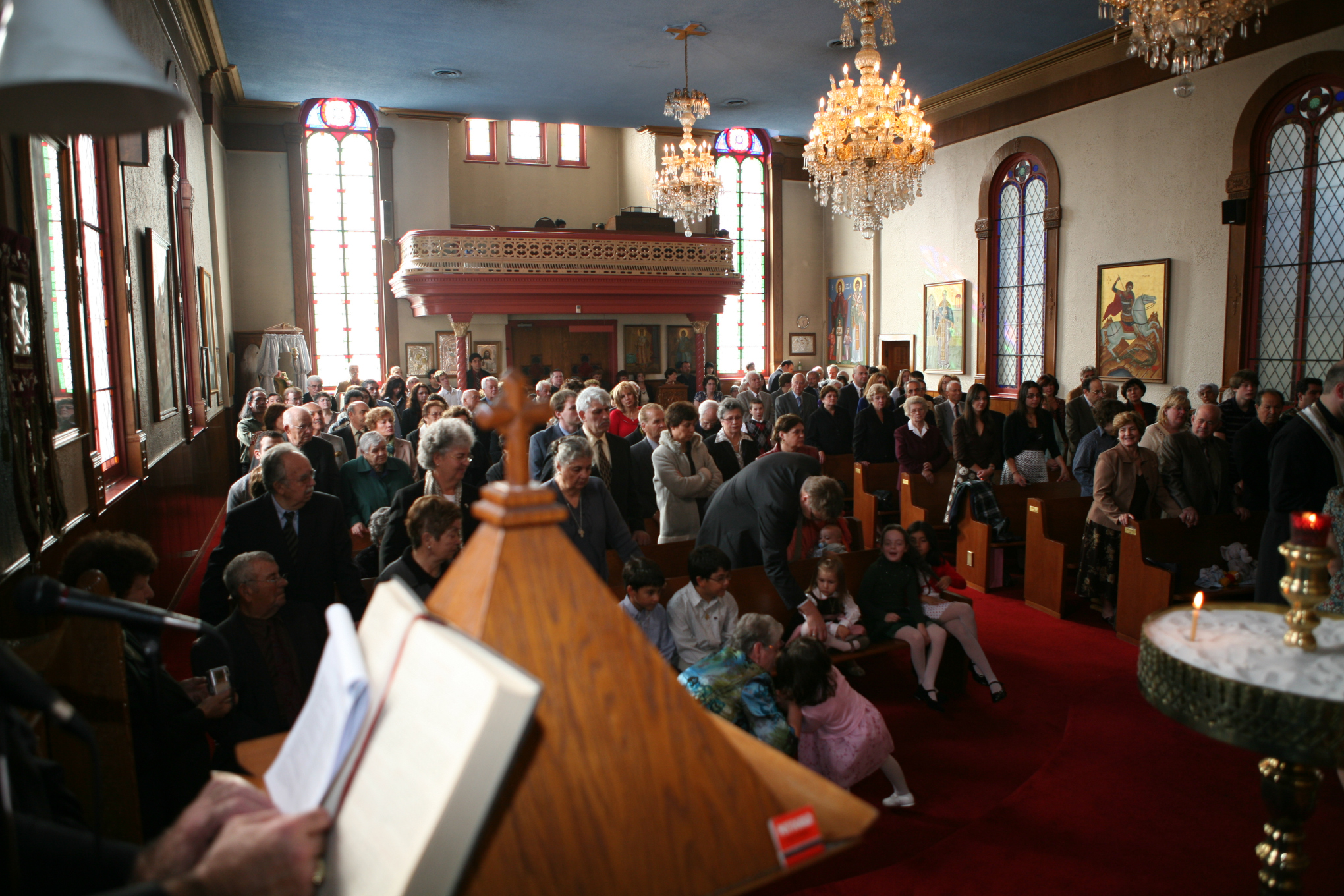
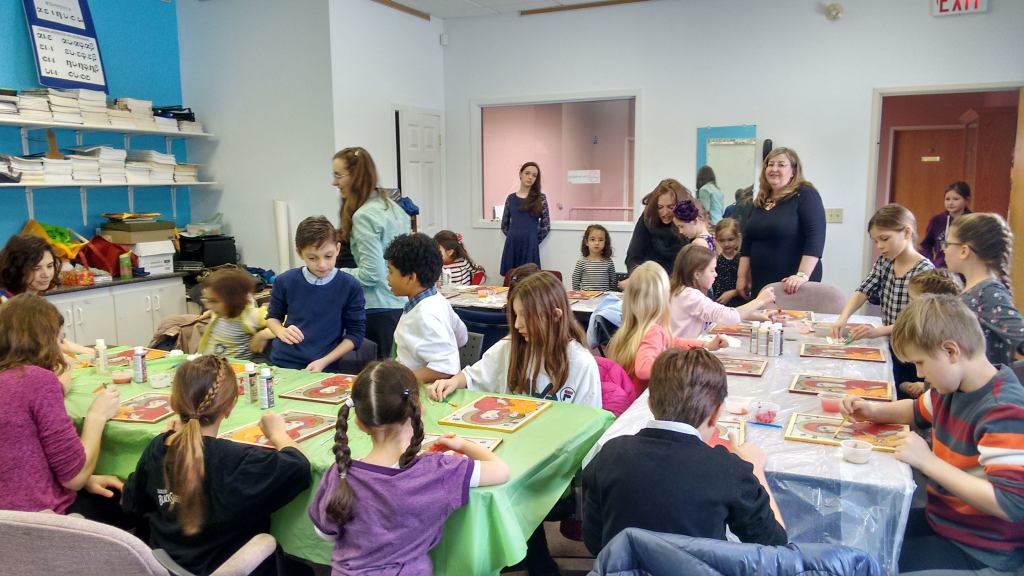
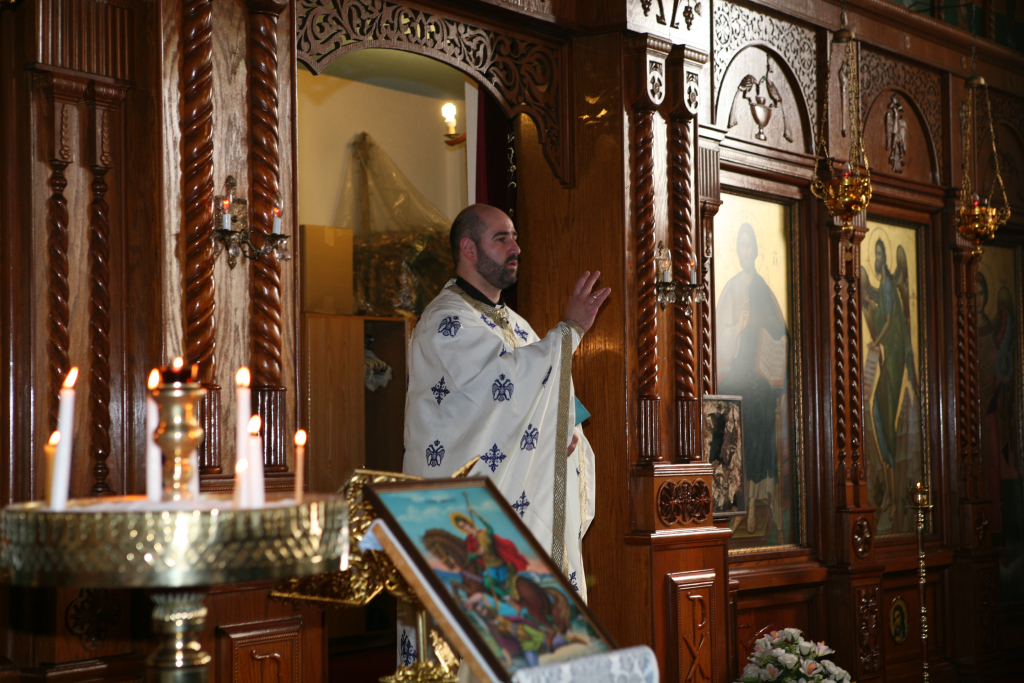
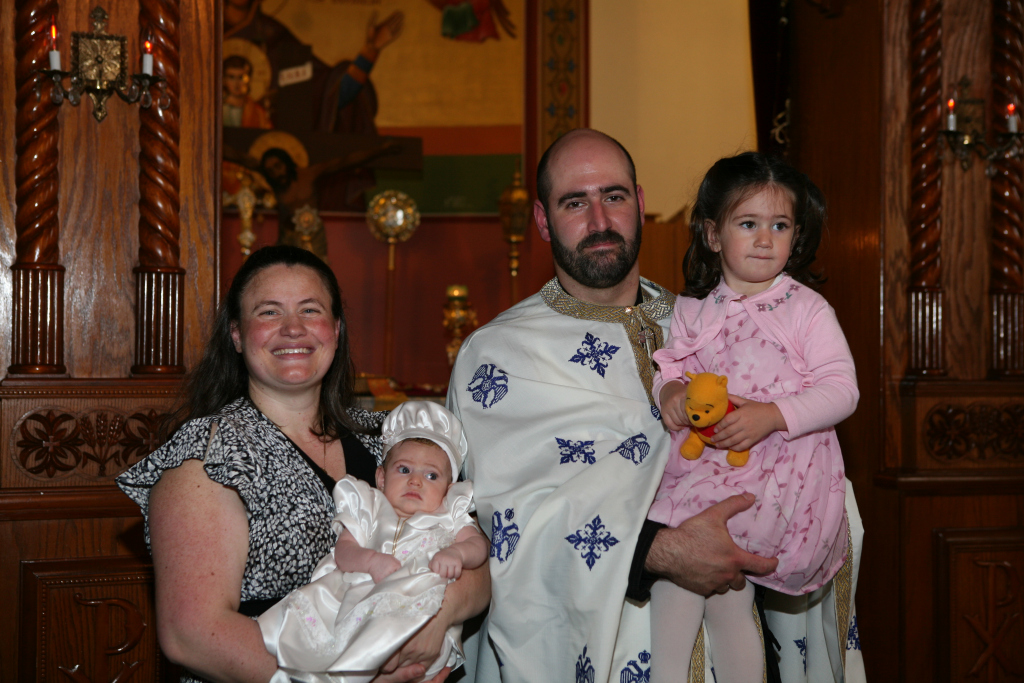
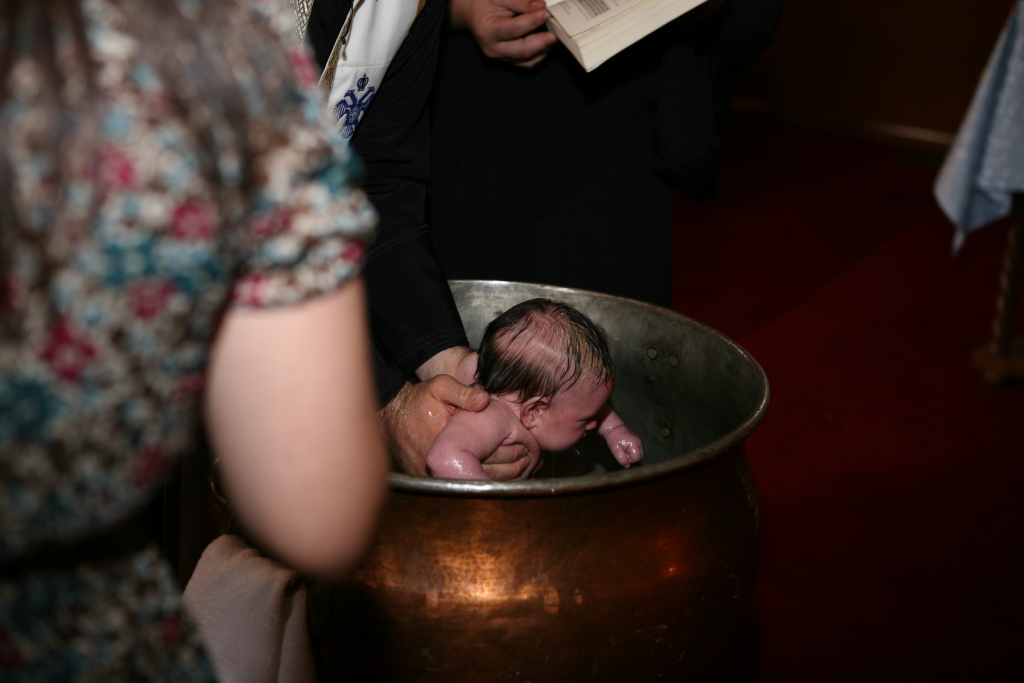
Below is a short video of a special Greek Orthodox church service at Kingston’s Greek Orthodox Church, to give you an audiovisual sense of the atmosphere of being within an Orthodox church.
In the following video, Father Matthew Penney gives an audiovisual tour of the Greek Orthodox Church:
INSIDE THE ORTHODOX CHURCH
Father Matthew Penney describes the components of the Orthodox Church, using our Koimisis Tis Theotokou (the Greek Orthodox Church in Kingston) to illustrate them.
When you first enter into the church, you enter into the narthex. Since this is where you step foot into the church from the street outside, the narthex serves as the bridge between our everyday life – our earthly life – and the kingdom of heaven.
Our church in Kingston was not originally orthodox; it was transformed into an orthodox church in the 1960s, and so our narthex is unusual. Typically, an Orthodox narthex would be larger so that there would be a clearly divided space between the entrance and the church to house the two sets of candles (one for the living and one for the dead), and the icons.
In the narthex, we have the icon for the church, depicting the saint or life event of Christ that the church is dedicated to. Ours is the Koimisis of Theotokou – or the Dormition of the Virgin Mary. The narthex contains this icon, along with icons depicting Christ and other saints, which we kiss in order to “greet”.
The main part of the Church is the nave. The nave represents entering into the kingdom of heaven, as it is the space leading up to the front of the church from the narthex. In an Orthodox church, you are meant to see richness and gold; your senses are meant to be overwhelmed, as the church is supposed to be a preview of the “splendor” of heaven. Around the church there are many large icons of important scenes in the life of the saints.
In the front part of the church, we are almost entering into the altar – or the “holy of holies”. The front of the church is the space before the Iconostas, or the icon wall separating the altar from the church. The church is laid out to show one ascending towards heaven, such as that the spaces from the narthex to the altar increase in importance.
The third distinct space is the altar area, or the “holy of holies”. Much of our worship within the church involves looking forwards towards it, as this space represents the very throne of the Holy Trinity. The altar holds the gospel, a cross, a tabernacle (with the communion bread), and much more.
The iconostasis (icon wall or icon stand) is the wall before the altar. It represents a threshold into the most holy space; and so on it we see icons depicting the most holy figures. First and foremost is, Jesus Christ. On either side of him are the figures most significant to him in his earth life: the Virgin Mary and St. John the Baptist. The icon beside the Virgin Mary’s is the icon of the saint or life event of the Church (ours is the Dormition Tis Theotokou). Above the doorway to the altar is an icon depicting the last supper, and around it are icons of the holy apostles.


